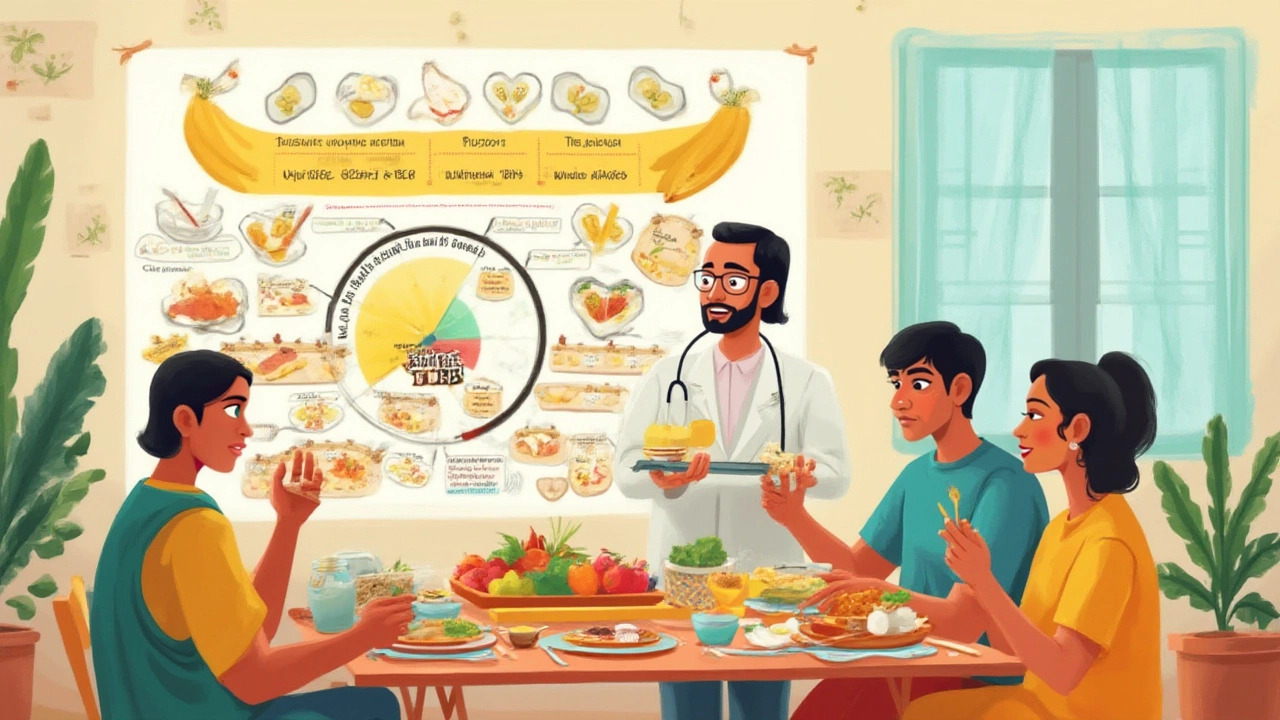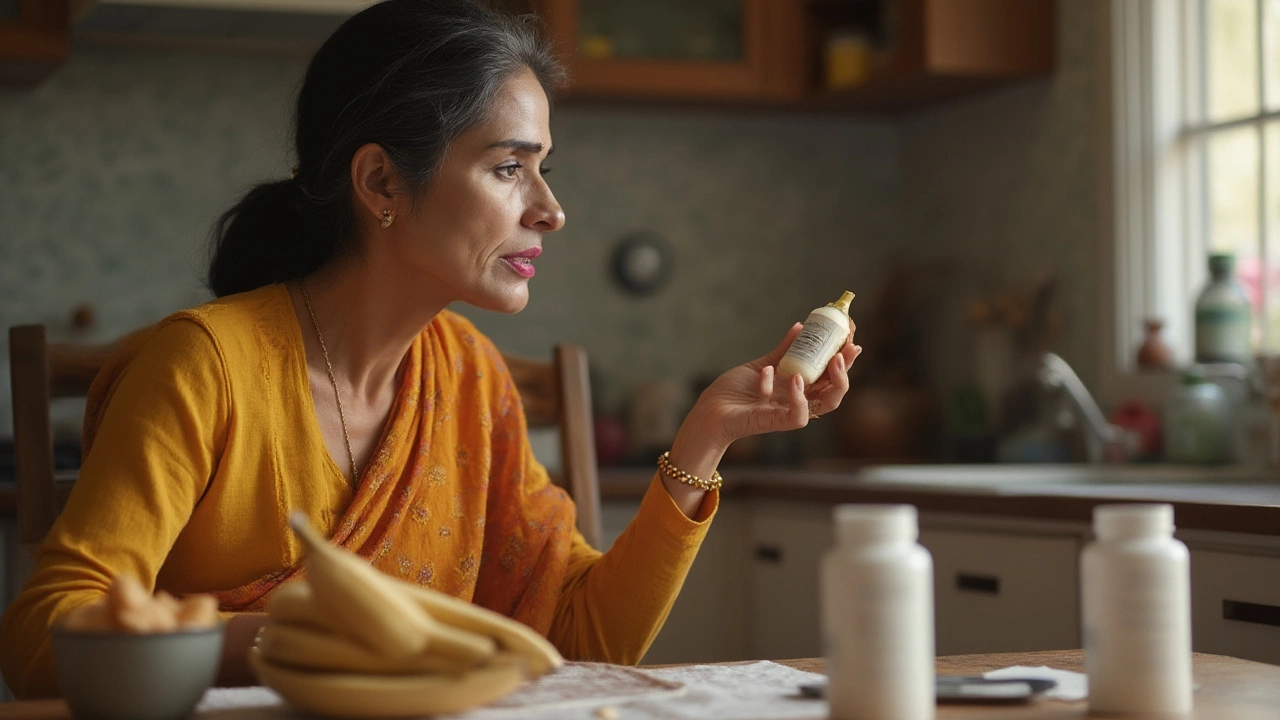Ever wondered if grabbing a banana is off-limits just because you’re on metformin? People with diabetes get told a dozen different things about fruit and blood sugar control, and bananas—being sweet and convenient—often spark a lot of confusion. They’re easy to toss into a bag for work, or slice on some morning oats, but no one wants to mess up their meds or risk spiking their blood sugar. Bella, my cat, may stick her nose up at bananas, but for the rest of us, there’s a real question here: can you safely mix bananas and metformin, or should you skip them for good?
What Does Metformin Do in Your Body – And How Food Ties In
To get to the bottom of this, let’s zoom in on what metformin actually does. It’s the most commonly prescribed pill for type 2 diabetes, and for good reason. Metformin lowers blood sugar mostly by making your liver dump less glucose into your blood. It can also help your body’s cells use insulin more efficiently, which lets your muscles and fat tissue gobble up excess sugar floating around. Millions of people worldwide use it, and it’s been proven to help prevent diabetes complications—heart problems, nerve issues, eye damage—over the long haul.
Now, here’s where food comes in. Doctors often say that people on metformin should eat regular meals and balance their carbs—not because metformin demands some special diet, but because you want to avoid giant blood sugar swings. Some foods can make this harder than others. Simple sugars, like those found in sodas or candy, can jack up your sugar quickly. But whole fruits, with their mix of fiber, natural sugars, vitamins, and water, behave differently than, say, jellybeans.
It’s a myth that you can’t have any sugar while taking metformin. Your body actually needs glucose to function, and it’s all about how fast and how much glucose hits your bloodstream. Bananas, in particular, have gotten some hate because they’re sweet, and their sugar comes in the form of fructose, sucrose, and glucose. But no single food is the enemy; it’s the big picture that matters.
Let’s not forget: metformin on an empty stomach can upset your stomach for some people. Eating a banana or any other food alongside your dose may help with this. Just avoid taking metformin right after a sugar bomb—for your gut’s and your glucose’s sake.
If you’re thinking, “I’m still confused”—you’re definitely not alone. So, is there something specifically about bananas that spells trouble, or is it just another internet myth? Buckle up, we’re cracking open some facts.
Banana Breakdown: What’s Really Inside This Popular Snack?
Bananas get their reputation for being sugary, but what’s actually in one medium banana (about 118 grams)? Here’s what the USDA shows, and science backs it up:
| Nutrient | Amount |
|---|---|
| Calories | 105 kcal |
| Carbohydrates | 27g |
| Fiber | 3g |
| Sugar | 14g |
| Potassium | 422mg |
| Vitamin B6 | 0.4 mg (22% DV) |
So, yes, there’s sugar, but there’s also a decent amount of fiber. That fiber helps slow the rate at which your blood sugar rises. The glycemic index (GI) of a ripe banana is around 51 to 55—not super low, but not in “danger zone” territory. Foods under 55 are considered low GI. Compare that to a white bagel or a 12-ounce soda—either of which will flood your system way faster.
The potassium in bananas also matters. Potassium helps control blood pressure, a big issue for diabetics. One banana packs in about 9% of the daily potassium adult bodies need. Bananas also give you vitamin B6, manganese, and a bit of vitamin C, all of which do their part for nerve health and immunity.
You might hear that “bananas turn straight to sugar.” Not true. Green or less ripe bananas have more so-called resistant starch—a type of carb that acts like fiber and doesn’t raise sugar much. As bananas ripen, starch converts to sugar, so yes, eating a super brown banana will hit your blood sugar more than a just-yellow one. But even ripe bananas usually don’t cause extreme spikes, especially when eaten in regular portions.
Portion size is key. So is what else you eat with it. Peel and eat a banana by itself, and your blood sugar may go up moderately. Slice that banana onto some Greek yogurt, nuts, or oatmeal, and the protein and fat slow down sugar absorption even more. This is why most dietitians say it’s fine to work bananas into a balanced meal plan. Bananas don't rank near the top of the "dangerous fruit" list for diabetics—grapes and watermelon, for instance, have a higher glycemic load per serving and are more likely to spike blood sugar fast.
Still, people on metformin need to keep an eye on potassium. Severe kidney problems (a rare side effect of metformin) may mean you have to limit potassium-rich foods, but this isn’t an issue for the vast majority. When in doubt, ask your doctor or dietitian. For most, bananas are safe in moderation, and the fiber actually helps offset some glucose effects.

How Bananas Affect Blood Sugar – What Science Says for People on Metformin
This is what it all comes down to: does eating a banana with metformin set off red flags in your bloodwork? Research gives us a pretty clear picture, and for people on the drug, bananas don’t land you in the danger zone—assuming you stick to reasonable portions and don’t treat a whole bunch as one snack.
Several scientific studies have looked at fruit and blood sugar management in type 2 diabetes. One Finnish study followed over a thousand people and found that those who ate more fruit—including bananas—had better long-term blood sugar control (measured by HbA1c tests) compared to those who skimped on fruit. Another trial out of Japan actually put participants on a daily banana snack and saw no shift in fasting blood sugar, as long as the rest of their diet was balanced and calorie-controlled.
Now, everyone’s response isn’t identical. Some folks may notice their blood sugar rise a bit more after a banana, especially if they eat it alone or when very ripe. If you ever wondered if you could test this on yourself, the answer is yes: try using a home glucose meter, check your levels before and two hours after eating half a banana, then do the same with a whole banana. Most people see a mild to moderate increase, not a wild spike. That’s a good sign for banana lovers out there.
Pairing bananas with protein or healthy fat is a useful trick. Cottage cheese, peanut butter, or a couple of boiled eggs can blunt blood sugar changes. You can also look for smaller bananas, which usually have fewer grams of carbs (think of the mini bananas you see at some grocery stores).
Bella, my cat, has her quirks, but she’s not worried about her blood sugar. Humans, however, should listen to what their own bodies tell them. If you notice you always feel sluggish or thirsty after bananas, it could mean you’re more sensitive. Keep a food diary and look for patterns, especially if your glucose readings seem off.
It’s easy to get bogged down by advice from random forums or neighborly gossip. The reality? You can include bananas with metformin—just keep it in context. Think serving size and timing, rather than making a forbidden food list. And don’t forget, your body needs a little fruit sugar to keep energy up, especially if you exercise. Skipping fruit entirely may mean you miss out on important nutrients, while giving in to fruit fear can make meals much less enjoyable.
Smart Ways to Enjoy Bananas While Taking Metformin
Okay, you’re convinced bananas aren’t taboo, but how do you work them into your life if you’re managing diabetes and taking metformin? Here are some real-world tips to keep things simple, safe, and tasty.
- Stick to one small or medium banana per day, or half if you’re worried about carbs. Remember, portion size matters more than the fruit itself.
- Choose just-ripe bananas (yellow with little or no brown). Overripe bananas have more sugar; green bananas have more resistant starch, which may be gentler on your blood sugar.
- Eat your banana with a meal that has some protein and healthy fat. Greek yogurt, nut butter, or eggs work well. This helps slow sugar absorption.
- Never skip your meds with the idea that it’ll “cancel out” the carbs—metformin and a healthy, balanced diet work best together.
- If you get stomach upset from metformin, eating a banana with your dose may help. Their fiber slows digestion and may ease queasiness.
- Keep an eye on your blood sugar, especially if you’re newly diagnosed or making changes. Some people are more sensitive to fruit carbs, even with metformin. Your meter is your best friend here.
- If you’re planning to exercise after eating, a banana is one of the best quick carb sources. It can help prevent low blood sugar crashes without causing wild swings the rest of the day.
- Mix things up: try other fruits lower in sugar, like berries, apples, or kiwi, if you’re worried about variety or carbs stacking up.
- If you have kidney issues or happen to be taking other medications that affect potassium, please check with your doctor before doubling up on high-potassium foods.
- Get creative! Slice bananas into oatmeal, blend into smoothies (with unsweetened milk and maybe some nuts), or freeze for a cool snack on hot days. Dessert doesn’t have to be a nightmare for your blood sugar.
For a lot of people, watching what they eat feels like a punishment. It shouldn’t. Being informed makes life easier—especially with metformin—so decisions don’t have to feel like guesswork. And trust me, food can still be fun. Even Bella the cat can get behind that idea—though she’d rather it be fish-flavored.





